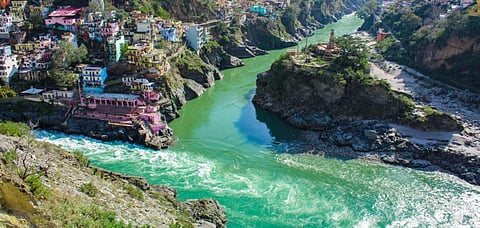
- Destinations
- Experiences
- Stay
- What's new
- Celebrating People
- Responsible Tourism
- CampaignsCampaigns
- SubscribeSubscribe
- Buy Now

Panch Prayag refers to the five revered sites in Uttarakhand where five rivers merge into the Alaknanda River, eventually forming the holy River Ganges (Ganga). In descending order of river convergence, the five places are Vishnuprayag, Nandaprayag, Karnaprayag, Rudraprayag, and Devprayag.
According to Hindu mythology, when Goddess Ganga descended to Earth, her force was too powerful to be contained. To curb her force, it is believed that she split into 12 channels, which eventually reunited completely after the confluence of the Alaknanda and Bhagirathi rivers at Devprayag, forming the mighty River Ganga once again.
Devotees from across the country visit these sites, believing that a dip in the waters at these spots purifies the soul and brings them closer to attaining moksha (liberation).
Located in the Chamoli district of Uttarakhand, Vishnuprayag is one of the region's five sacred confluences of rivers, where the Alaknanda River merges with the Dhauliganga River. Vishnuprayag is derived from two words Vishnu, referring to Lord Vishnu, and Prayag, meaning confluence. The Alaknanda River originates from the Satopanth Glacier, while the Dhauliganga River is formed by merging several smaller streams from the Nanda Devi and Nanda Ghunti peaks. Together, the two rivers meet at Vishnuprayag. The place also has an ancient temple called Vishnu Kund, dedicated to Lord Vishnu. It is believed that the sage Narad, known for his devotion to Lord Vishnu, performed intense penance and worshipped Lord Vishnu at this very spot.
The prominent site also serves as a starting point for various treks and expeditions in the region. It is a popular base camp for trekking routes leading to destinations like Badrinath, Hemkund Sahib, Valley of Flowers, and Mana Village. Adventure enthusiasts and nature lovers flock to this place to explore the beauty of the Himalayas and indulge in activities like trekking, camping, and river rafting.
Nandaprayag is the meeting point of the Alaknanda River and the Nandakini River, where the two rivers merge to form a single stream. Nandaprayag holds great religious and mythological importance. According to one legend, King Nanda performed a grand yajna (fire ritual) at this spot to appease the gods and seek their blessings. It is believed that his devotion and the sacredness of his offerings were so powerful that the gods themselves appeared before him. Another popular legend is that Nandaprayag got its name from King Nanda, the foster father of Lord Krishna. The place is also home to the renowned Gopalji temple, dedicated to Lord Krishna.
Apart from its religious significance, Nandaprayag serves as a base for exploring the nearby attractions, including trekking routes, scenic trails, and pilgrimage sites. It provides a gateway to several destinations in Uttarakhand, such as Badrinath, Valley of Flowers, and Hemkund Sahib.
Karnaprayag marks the confluence of the Alaknanda River and the Pindar River. It holds both religious and historical importance. According to Hindu mythology, Karna from the epic Mahabharata meditated at this spot for many years. He sought to acquire an impregnable shield through meditation, making him invincible on the battlefield. The Alaknanda and Pindar rivers' confluence is believed to be where Karna performed his intense penance. It is also believed that Swami Vivekananda, the revered Indian spiritual leader, also meditated here with his disciples.
Besides, Karnaprayag is also the sub-divisional headquarters of the Chamoli district and serves as an essential transit point for pilgrims and tourists on their way to the famous Hindu pilgrimage site of Badrinath. It also connects to Jim Corbett National Park and prominent Kumaon regions like Almora and Nainital.
Rudraprayag is a small pilgrim town located at the confluence of the Alaknanda and Mandakini rivers in Uttarakhand. Legend has it that Narad Muni worshipped Lord Shiva at Rudraprayag to gain mastery over music, and then Lord Shiva appeared in his Rudra avtar (incarnation) to bless Narad Muni.
The town has important religious sites, including the Shiva and Jagdamba temples. Formerly a part of the Chamoli and Tehri districts, Rudraprayag became a separate district in 1997. It serves as a junction for those visiting the revered pilgrimage sites of Badrinath and Kedarnath Dham.
Located in the Tehri Garhwal district of Uttarakhand, Devprayag is a pilgrimage town known for marking the confluence of the Alaknanda and Bhagirathi rivers, which merge to form the holy River Ganga. It falls on the route from Rishikesh to Badrinath.
Devprayag is the final confluence, signifying the beginning of the journey of the Ganga towards the plains and eventually to the Bay of Bengal. Despite a devastating earthquake in 1803 that destroyed the entire town, the heritage structures of Devprayag were restored, preserving its ancient charm.
By Road: All five Prayags are well connected by road with various important towns and hill stations in Uttarakhand. The cities of Rishikesh, Kotdwar, Dehradun, Haridwar, and other significant hill stations in the Garhwal and Kumaon regions have good road connectivity to the Prayags.
By Air: The airport is located in Dehradun and is approximately 239 kilometres from the five towns.
By Train: Rishikesh is the nearest railway station to reach all five Prayags. It is well-connected to various major cities in India.
